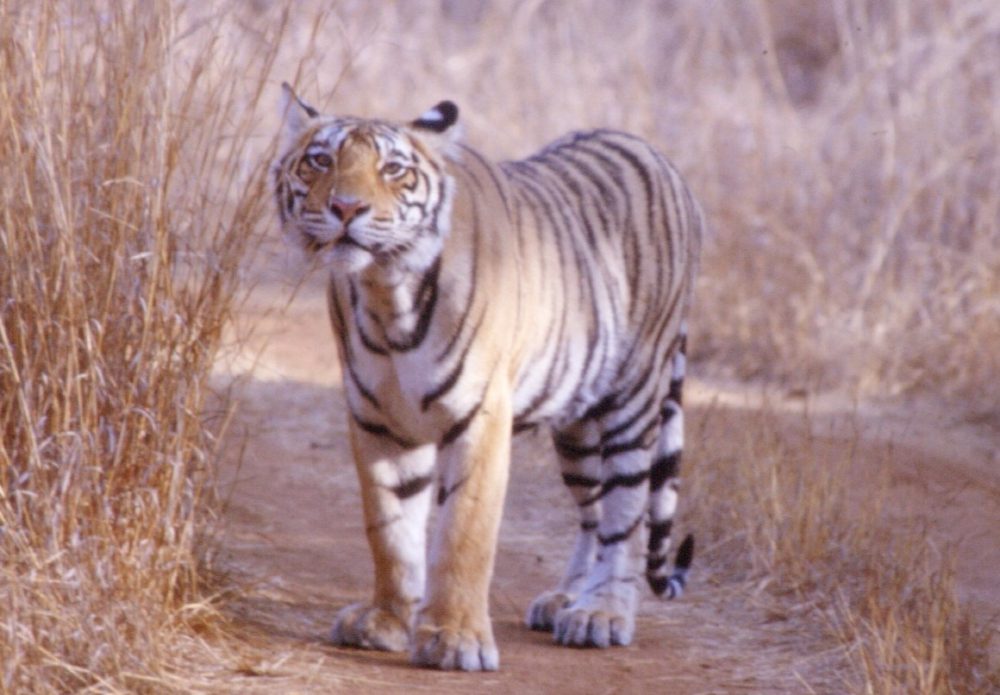By Neena Bhandari
Kanha (Madhya Pradesh, India) 29.11.2001 (Sydney Morning Herald): As a child I would snuggle into my father’s arms in the “watch towers” strategically positioned in wildlife sanctuaries, and watch a tiger devour its bait. We would wait for hours in the thick of the night, straining our ears to hear that familiar ruffle of leaves caused by a stealthy predator.
Over the years the practise of baiting tigers for viewing has been discontinued, but encounters with big cats are not uncommon in the 27 tiger reserves of India, where this threatened species has learnt to live with man and vehicles.
Watching a proud tigress stretching with three playful cubs frolicking around her, or a majestic tiger enjoying a siesta, slowly turning to stretch a paw and yawn, are images I have grown up with. Having had the opportunity to see tigers at close quarters in sanctuaries from Ranthambore in the west to Sunderbans in the east, Corbett in the north to Periyar in the south, the experience that sticks with me is the Kanha National Park in the central Indian state of Madhya Pradesh.
A tiger almost always gives an audience in Kanha, immortalised by Rudyard Kipling in his “Jungle Book” as the home of Balu, Bagheera and Mowgli.
We reached Jabalpur, the nearest railway station for the national park and a town famous for its marble rocks, on a spring morning. The journey ahead was a bumpy road ride through the Satpura ranges and thick teak forests.
On crossing the Narmada, a river that made headlines over a controversial proposal to dam it, the ambience suddenly changed. The road was smoother, the sounds of heavy vehicles faded, and avenues of tall Sal (Shorea Rubusta) trees grew thicker with birds, insects and butterflies.
Children from the nearby Gond and Baiga tribal villages rushed out of their thatched huts to wave at the passing tourists. These indigenous people, referred to as the “sons and daughters of mother Earth”, have lived in these forests practising shifting cultivation since time immemorial.
A three-and-a-half hour ride brought us to Kisli, one of the two entrances to the national park. The forest guesthouse here, built in 1926, harks back to the days of the British Raj.
Arriving at night, I was taken aback by the stars overhead. In that overwhelming darkness the constellations appeared so clear and near. The laughter of the hyena, the roar of the tiger and shrill cries of the spotted deer and monkeys greeted us. The jugnus (fire flies) flashed like sparks of light. Then the housekeeper, Jagdish, cautioned me to get indoors as leopards often strolled into the corridors at night.
Securely tucked under a mosquito net, I read H S Panwar’s book on Kanha, a fascinating account of his 13 years as Field Director of the park and later Director, Project Tiger and one of the main forces behind the setting up of the Wildlife Institute of India in Dehra Dun. Encounters with the wild in the coming days almost brought the print alive.
We set out early next morning for our first encounter with the tiger. The sun was just breaking through the Sal trees; the mild scent of their small off-white flowers filled the air. There were countless hives with honeybees swarming.
Ravnu Lal, a mahout (elephant trainer), informed the forest guards on his wireless of the presence of two tiger cubs nearby. The message was flashed to the 30-odd tourist jeeps, the maximum number allowed in the park at any one time. The five mahouts on their faithful elephants transported tourists inside the dense forests for a closer look.
From our elevated vantage points we saw the sinews tightening on the face of one of the tiger cubs. With every step of the elephant, his head turned, occasionally roaring, apparently angry at the intrusion. The other cub slept while tourists peered through their binoculars and cameras.
From 48 tigers in 1973, Kanha now boasts more than 100. We also encountered a solitary, fully grown male tiger walking stealthily through the forest and giving the mahouts a tough time keeping up. He was so close to us that his taut body almost rubbed against the elephant’s legs. The beautiful stripes on his golden skin and his powerful roar kept us in awe as he sat under a tree.
The 20 mahouts and their assistants make these encounters possible daily for the nearly 50,000 tourists who visit this park each year. Since 1980 elephants have also been breeding in the park. Each one is fed a special daily diet of nine kilograms of wheat, 250 grams of salt and one kilogram of jaggery (raw palm sugar).
As you manoeuvre along forest roads, the hills, the plateau, the meadows, the plains and the streams unfold before you. Kanha is one of the few national parks which encompasses all these features. Here, also, an amazing chain of interdependence exists among the residents: the tiger, leopard, dhole (wild dog), spotted deer, sambhar, barasingha (a type of deer), blue bull, Indian bison, hyena, jackal, hare, porcupine, sloth bear, blackbuck, wild boar, monitor lizard, garden lizard, fan throated lizard, flying lizard, chameleon, insects, spiders and butterflies.
The meadows are home to herbivores like sambhars and nearly 20,000 spotted deer, which feed on the grasses and shrubs and raise their fawns here. At different periods, areas that have been grazed are enclosed to rejuvenate them for the next season. These meadows were once tribal settlements, but the tribal people have been relocated outside the core area of the national park.
For example, if you see a troop of langurs in a tree, you’re sure to find a herd of spotted deer below. The langurs slender, long-tailed monkeys are the first to give the alarm when a predator approaches, allowing the spotted deer to flee. Both are versatile feeders, though langurs are rather selective in their eating habits. They pluck fruits and throw half-eaten ones on the ground; their swift movements through the trees also cause leaves, flowers and fruits to fall. Spotted deer benefit from this behaviour, eating all that drops to the ground.
Beyond the rolling meadows are the handsome barasingha, sparring with their antlers to assert rights to territory and females. A mature stag has 10 to 14 tines. A male barasingha aspiring to take over the herd or territory along with the females must first prove his might in a sparring bout with the herd’s reigning stag. The barasingha have a special place in the annals of Kanha. At one time, the Branderi sub-species found in the central highlands had almost reached the end of its journey. It was hunted and poached and its grassland habitat was rapidly being claimed for agriculture. With numbers dwindling to 66 in 1970, it was at the brink of extinction. Today the population has recovered to more than 500.
Moving along the mixed deciduous forests, you can’t miss the termite “palaces”, some two or three metres high. They house a king and a queen as well as hundreds of workers and soldiers; sometimes hundreds of thousand tiny creatures live inside them. Termite hills are built with dry wood or tree stumps mixed with soil and saliva. The ant’s digestive system helps turn dead and decaying vegetation into soil-enriching nutrients. The mighty sloth bear can rip open an ant mound with its sickle-shaped claws, sucking out the insects with its snout.
The trees are draped with large creepers and thick foliage. There are several fruit bearing trees, orchids and monocots. In their branches and on neighbouring lakes and rivers, birds abound. You can see the bright hued golden oriole and hear the mellifluous brainfever bird (common hawk cuckoo or Cuculus varius), popularly known as the papiya. A loud screaming call that sounds like “brain fever, brain fever” gives the bird its name. Local people have translated this to pee-kahan or “Where is my love?”
The park has a total area of 1945 square kilometres comprising 940 square kilometres of core forest and 1005 square kilometres of buffer zone. The epicentre of the reserve, which once housed tourists, is a museum. The photographs, drawings, skeletons, stuffed creatures and exhibits dating back to 1910 take the visitor on a fascinating and interactive journey through the park. But, interesting as the display is, nothing can displace the thrill of experiencing Kanha an idyllic, wild abode and one of the truly protected habitats of the tiger, for yourself.
Today, one can enjoy nature and wildlife from cosy comforts of rest houses and resorts in and around these tiger reserves, but in days goneby we slept on camp cots under star-lit skies. My mother would neatly create a fence of caned chairs to protect us from strolling hyenas and jackals. Winter nights were spent inside log-huts with bare necessities, but nothing would diminish the fear and excitement of `tiger sightings’ then or now with all the luxury.
© Copyright Neena Bhandari. All rights reserved. Republication, copying or using information from neenabhandari.com content is expressly prohibited without the permission of the writer and the media outlet syndicating or publishing the article.



Lovely Neena. Kanha came alive for me through your words. Though I have sighted tigers couple of times at Ranthambore – specially one dry hot summer, I’ve always wanted to go to Kanha! Next stop Jabalpur!
I really enjoyed the article and the vivid description made me feel like I was experiencing it with you!
Very interesting indeed,Neena! Enjoyed reading it…. More so because I had spent two days there with my family some years ago and your article made me relive the thrill of some very special moments of ‘ tiger sighting’.
How lucky you are to have such memories. I was with you as you took us through the Kanha National Park. I’ve been to a couple of wildlife reserves but yet to see a tiger.